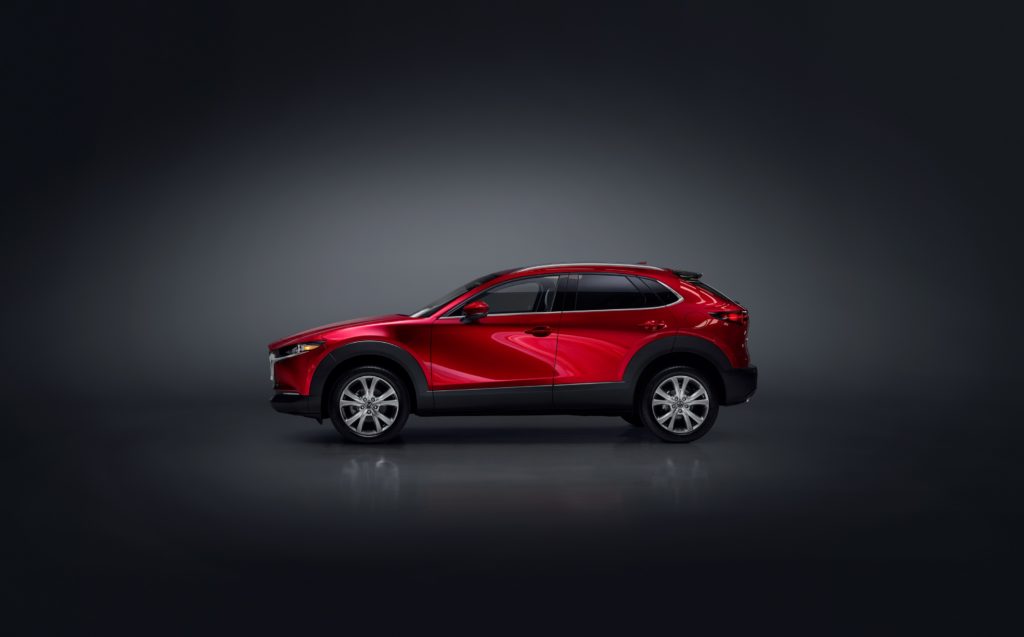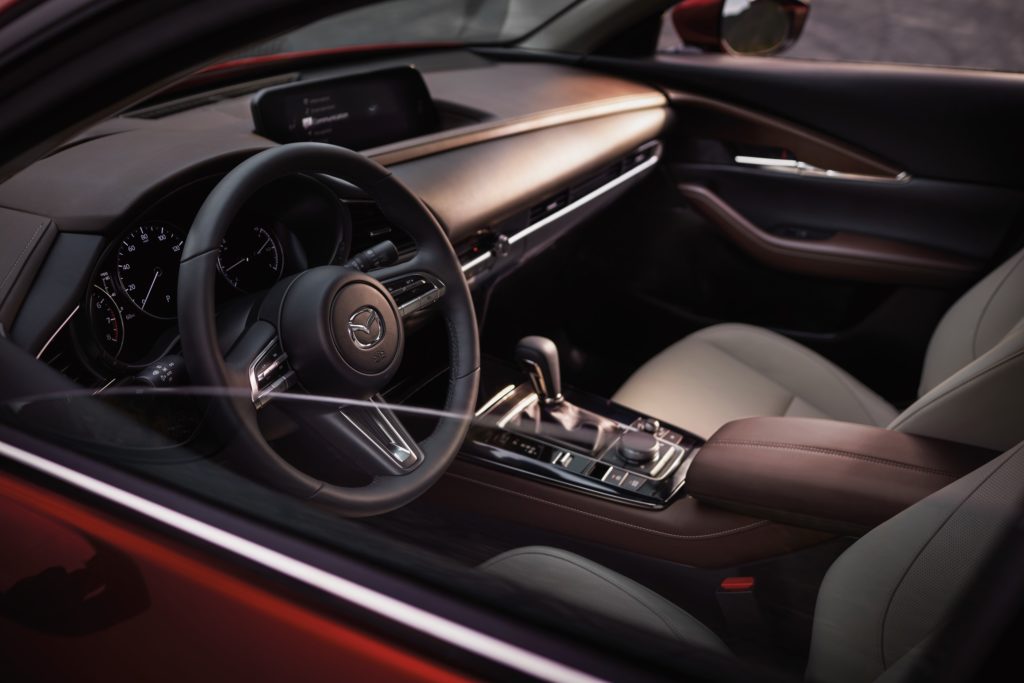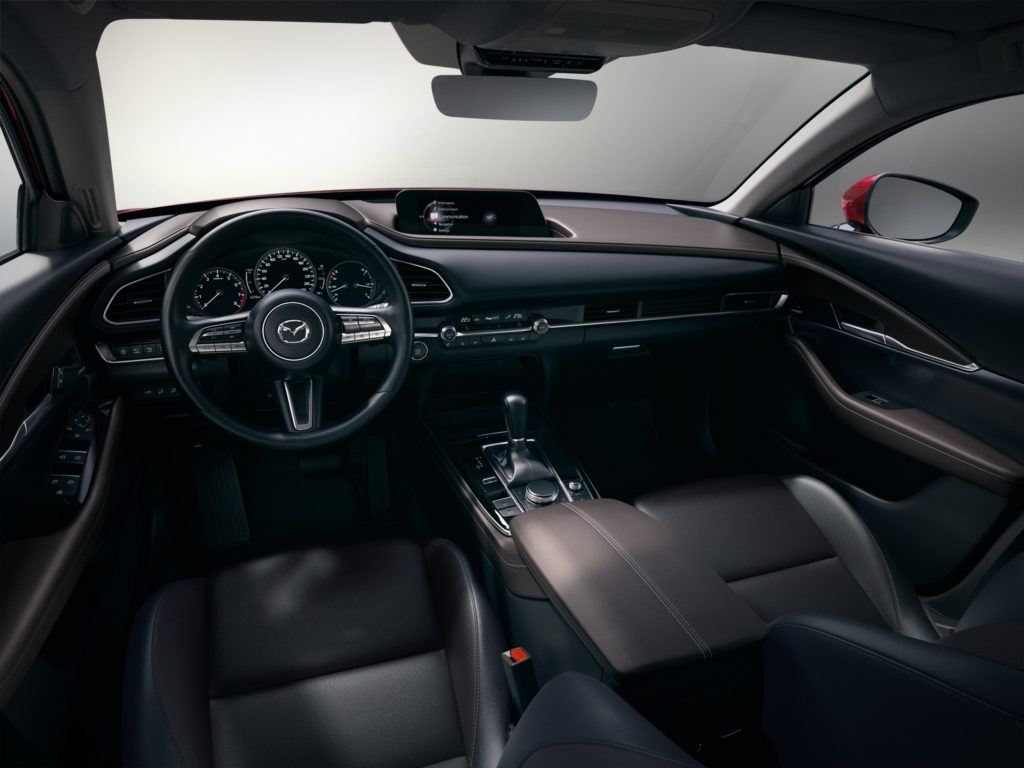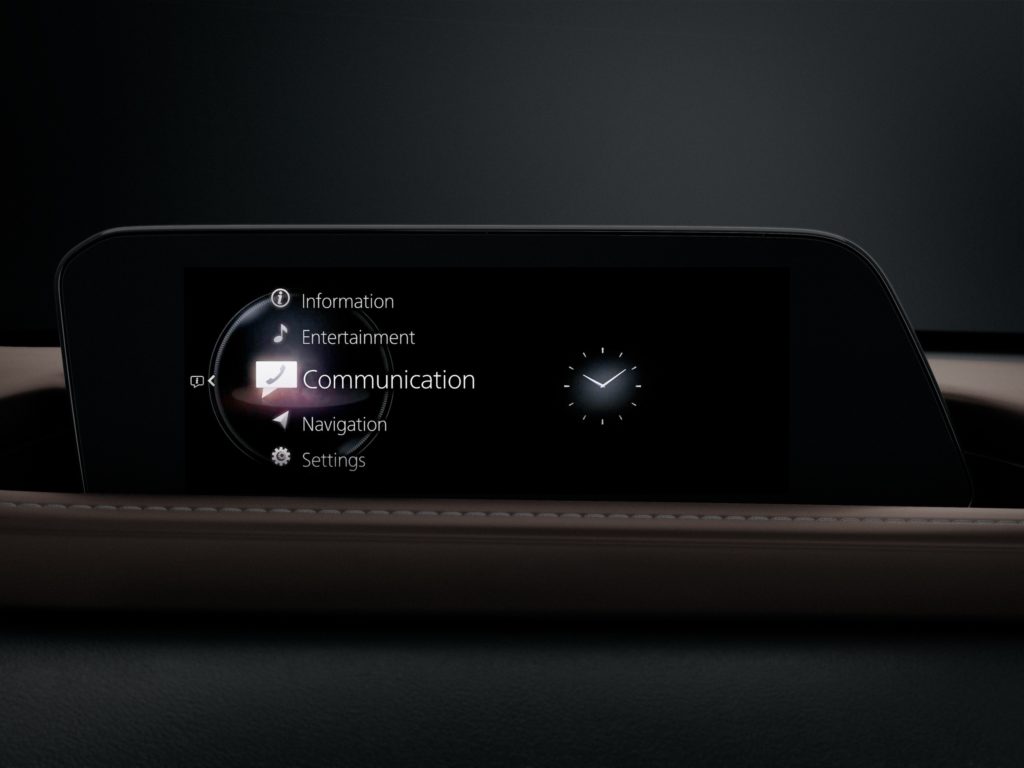The new Mazda CX-30 is the second production model to adopt the latest evolution of Mazda’s Kodo design philosophy – artful design which is deeply rooted in traditional Japanese aesthetics. The honing of every element according to the ‘less is more’ principle has created unprecedentedly clean, beautiful surfaces and brought an entirely original form to the compact crossover SUV segment.
The Mazda Vision Coupe concept model introduced in 2017 embodied this more sophisticated design language through finely honed, minimalist styling: its elegantly restrained body form generating a delicate play of light and reflections that change over time to create styling with a natural, dynamic feel.
 The styling is controlled by a new design expression: ‘Charge and Release’. This style was derived from the brushwork used in Japanese calligraphy and developed to integrate the three key factors of the evolved Kodo design theme: Yohaku, the beauty of empty space; Sori, curves with poise and balance; and Utsuroi, the play of light and shade.
In particular, Sori is clearly embodied in the arc of the shoulder running from the front wing to the rear wheel, giving a sense of speed and vitality. Utsuroi may be seen in the body surfaces beneath the shoulder line, which reflect the surroundings in an S shape that changes as the car moves. These expressions of body form finally come together in a single undulation at the rear where they diffuse. By eschewing character lines in favour of the movement of surfaces, the Mazda CX-30 achieves styling with both the beauty of a work of art and a powerful sense of dynamism.
The front styling conveys a refined, yet bold personality. Mazda’s signature wing takes on a sharper and deeper form that combines with the solid, sculpted contours of the front bumper to achieve a composition strongly suggestive of forward motion. The size and pattern of the radiator grille’s triangular motif are tightly controlled to show rich variations according to the viewing angle and changes in light.
From the back, the rear wings stand proud from the tapered rear cabin and the tailgate has a correspondingly narrowed arch shape. In combination, this creates a sensuously powerful rear form akin to the wide, dynamic stance of a sports car.
The styling is controlled by a new design expression: ‘Charge and Release’. This style was derived from the brushwork used in Japanese calligraphy and developed to integrate the three key factors of the evolved Kodo design theme: Yohaku, the beauty of empty space; Sori, curves with poise and balance; and Utsuroi, the play of light and shade.
In particular, Sori is clearly embodied in the arc of the shoulder running from the front wing to the rear wheel, giving a sense of speed and vitality. Utsuroi may be seen in the body surfaces beneath the shoulder line, which reflect the surroundings in an S shape that changes as the car moves. These expressions of body form finally come together in a single undulation at the rear where they diffuse. By eschewing character lines in favour of the movement of surfaces, the Mazda CX-30 achieves styling with both the beauty of a work of art and a powerful sense of dynamism.
The front styling conveys a refined, yet bold personality. Mazda’s signature wing takes on a sharper and deeper form that combines with the solid, sculpted contours of the front bumper to achieve a composition strongly suggestive of forward motion. The size and pattern of the radiator grille’s triangular motif are tightly controlled to show rich variations according to the viewing angle and changes in light.
From the back, the rear wings stand proud from the tapered rear cabin and the tailgate has a correspondingly narrowed arch shape. In combination, this creates a sensuously powerful rear form akin to the wide, dynamic stance of a sports car.
 The design of the Mazda CX-30’s cabin is based on Mazda’s human-centered design philosophy, and traditional Japanese architecture. The basic layout combines a snug and condensed cockpit area for the driver, and a clean, airy open space around the front passenger.
The design of the Mazda CX-30’s cabin is based on Mazda’s human-centered design philosophy, and traditional Japanese architecture. The basic layout combines a snug and condensed cockpit area for the driver, and a clean, airy open space around the front passenger.
 A wide floor console groups the gear lever, cup holders and Multimedia Commander controller forward in a ‘control area’ close to the driver for convenient, ergonomically easy operation, while the gently curved knee rests and arm rest behind create a warm, contrasting atmosphere.
For the driver, the CX-30 delivers on the ‘Jinba Ittai’ car and driver as one ethos you’d expect from Mazda, with a cabin design that provides an ideal driving position for occupants of all sizes. The steering wheel’s 45mm tilt and 70mm telescopic range enables precise adjustment of the driving position. In addition, front seat cushion tilt adjustment is fitted as standard to help prevent the occupant’s thighs floating above the cushion (seat angle too low) or placing undue pressure on the thighs (seat angle too high).
Mazda’s engineers also focused on the importance of visibility and people’s subconscious awareness of spatial axes, and their ability to determine distance and speed when moving through a given space. For example, the belt line along the upper section of the door trim and lines of the floor console come close to tracing the path of the lane markers that can be seen through the window. Also, the lines of the dial hood extend forward toward the point at which the lane markers converge, enhancing drivers’ spatial awareness.
The thickness and shape of the A-pillars have been optimized to reduce blind spots; the C-pillar is shaped to provide optimal visibility out of the rear quarter window, while the rear door and quarter windows allow drivers to easily see vehicles positioned diagonally behind the car.
Other examples of this attention to detail include windscreen wipers that constantly adjust their operating angle in fine increments, allowing them to clean right up to the A-pillar and secure visibility near the driver’s side A-pillar. They are also housed beneath the hood to help provide a clear downward view out of the screen, while the washer nozzles are attached to the wiper arms so their spray can be wiped away immediately after application and not interfere with visibility.
The driver was also centre of mind with the design of the interfaces in the CX-30. The standard Color Active Driving Display (Head-Up Display) system, driving dials and central display screen have all been designed to present information in a clear, simple fashion, while the fonts used have been unified to create a pleasing and consistent look. The Mazda CX-30 adopts an 8.8-inch wide-screen centre display, which offers simple, straightforward operation via the intuitive Multimedia Commander controller.
Adopting the recently enhanced Mazda Connect system, drivers of the Mazda CX-30 will benefit from its significantly improved safety and user-friendliness.
When developing the standard audio system, Mazda carried out comprehensive studies into how sounds are transmitted through a car’s cabin. This led to locating the 3L bass speakers in the front cowl sides where low-frequency sound is better reproduced, resulting in a more clearly audible lower register, while 2.5cm tweeters and 8cm midrange units have been positioned on the left and right side garnish, and on the upper section of the front and rear door trim respectively, where the sound is transmitted directly towards the occupant’s ears. This more powerfully and naturally locates the sound’s origin, enhancing both depth and clarity.
For all the delivery of quality materials, generous standard equipment, refinement and driver comfort, Mazda’s engineers did not forget how important practicality is to SUV buyers. This focus on space and comfort resulted in a notably well packaged and versatile interior. Slotting into the range between the CX-3 and CX-5, the CX-30 enters a new market segment for Mazda. With the design goal for overall length set at 4,400mm or less, it fulfils all the requirements of customers who wish to combine the compact, urban-friendly dimensions of the former with the space and practicality of the latter.
Practicality
A generous distance of 740mm between the front seats is 50mm greater than in the Mazda CX-3, and on par with that of the Mazda CX-5. The spacing of the front seats allows for a wide floor console with a refined layout and a large centre armrest. Equally spacious rear seat separation facilitates big rear centre armrest and door armrests, allowing rear seat occupants to enjoy a comfortable, relaxed seating posture.
The space between front and rear seat hip points and a low rear seat hip-point height create ample knee and headroom, enabling taller passengers to occupy the rear seats in comfort. Moreover, the wide spacing of the seats, both fore-aft and laterally, makes it easier for people in the front to turn and face people in the rear.
Despite an SUV-appropriate ground clearance, low seat hip-point heights of 601mm for the front seats and 619mm for those at the rear combine with generous door opening heights to allow for easy entry and exit from the Mazda CX-30. In addition to the generous distance between the front and rear seats and the low rear floor height, the shapes of seat cushions and B-pillars have been optimized to accommodate the movement of passengers during entry and exit. Moreover, side seals have been added to the bottom of the rear doors, preventing occupants from dirtying their clothing when exiting a muddy vehicle.
Luggage capacity is a generous 430 liters, enough to simultaneously accommodate a large, global-standard baby buggy and a carry-on bag. The boot opening width is 1,030mm, while the height of the loading lip is just 731mm, for easy loading and unloading of heavy or bulky cargo. The power operated tailgate features one touch opening and closing for more convenience.
With its combination of quality, premium materials, smart design and practicality the Mazda CX-30 sets new standards for a Mazda SUV cabin.
A wide floor console groups the gear lever, cup holders and Multimedia Commander controller forward in a ‘control area’ close to the driver for convenient, ergonomically easy operation, while the gently curved knee rests and arm rest behind create a warm, contrasting atmosphere.
For the driver, the CX-30 delivers on the ‘Jinba Ittai’ car and driver as one ethos you’d expect from Mazda, with a cabin design that provides an ideal driving position for occupants of all sizes. The steering wheel’s 45mm tilt and 70mm telescopic range enables precise adjustment of the driving position. In addition, front seat cushion tilt adjustment is fitted as standard to help prevent the occupant’s thighs floating above the cushion (seat angle too low) or placing undue pressure on the thighs (seat angle too high).
Mazda’s engineers also focused on the importance of visibility and people’s subconscious awareness of spatial axes, and their ability to determine distance and speed when moving through a given space. For example, the belt line along the upper section of the door trim and lines of the floor console come close to tracing the path of the lane markers that can be seen through the window. Also, the lines of the dial hood extend forward toward the point at which the lane markers converge, enhancing drivers’ spatial awareness.
The thickness and shape of the A-pillars have been optimized to reduce blind spots; the C-pillar is shaped to provide optimal visibility out of the rear quarter window, while the rear door and quarter windows allow drivers to easily see vehicles positioned diagonally behind the car.
Other examples of this attention to detail include windscreen wipers that constantly adjust their operating angle in fine increments, allowing them to clean right up to the A-pillar and secure visibility near the driver’s side A-pillar. They are also housed beneath the hood to help provide a clear downward view out of the screen, while the washer nozzles are attached to the wiper arms so their spray can be wiped away immediately after application and not interfere with visibility.
The driver was also centre of mind with the design of the interfaces in the CX-30. The standard Color Active Driving Display (Head-Up Display) system, driving dials and central display screen have all been designed to present information in a clear, simple fashion, while the fonts used have been unified to create a pleasing and consistent look. The Mazda CX-30 adopts an 8.8-inch wide-screen centre display, which offers simple, straightforward operation via the intuitive Multimedia Commander controller.
Adopting the recently enhanced Mazda Connect system, drivers of the Mazda CX-30 will benefit from its significantly improved safety and user-friendliness.
When developing the standard audio system, Mazda carried out comprehensive studies into how sounds are transmitted through a car’s cabin. This led to locating the 3L bass speakers in the front cowl sides where low-frequency sound is better reproduced, resulting in a more clearly audible lower register, while 2.5cm tweeters and 8cm midrange units have been positioned on the left and right side garnish, and on the upper section of the front and rear door trim respectively, where the sound is transmitted directly towards the occupant’s ears. This more powerfully and naturally locates the sound’s origin, enhancing both depth and clarity.
For all the delivery of quality materials, generous standard equipment, refinement and driver comfort, Mazda’s engineers did not forget how important practicality is to SUV buyers. This focus on space and comfort resulted in a notably well packaged and versatile interior. Slotting into the range between the CX-3 and CX-5, the CX-30 enters a new market segment for Mazda. With the design goal for overall length set at 4,400mm or less, it fulfils all the requirements of customers who wish to combine the compact, urban-friendly dimensions of the former with the space and practicality of the latter.
Practicality
A generous distance of 740mm between the front seats is 50mm greater than in the Mazda CX-3, and on par with that of the Mazda CX-5. The spacing of the front seats allows for a wide floor console with a refined layout and a large centre armrest. Equally spacious rear seat separation facilitates big rear centre armrest and door armrests, allowing rear seat occupants to enjoy a comfortable, relaxed seating posture.
The space between front and rear seat hip points and a low rear seat hip-point height create ample knee and headroom, enabling taller passengers to occupy the rear seats in comfort. Moreover, the wide spacing of the seats, both fore-aft and laterally, makes it easier for people in the front to turn and face people in the rear.
Despite an SUV-appropriate ground clearance, low seat hip-point heights of 601mm for the front seats and 619mm for those at the rear combine with generous door opening heights to allow for easy entry and exit from the Mazda CX-30. In addition to the generous distance between the front and rear seats and the low rear floor height, the shapes of seat cushions and B-pillars have been optimized to accommodate the movement of passengers during entry and exit. Moreover, side seals have been added to the bottom of the rear doors, preventing occupants from dirtying their clothing when exiting a muddy vehicle.
Luggage capacity is a generous 430 liters, enough to simultaneously accommodate a large, global-standard baby buggy and a carry-on bag. The boot opening width is 1,030mm, while the height of the loading lip is just 731mm, for easy loading and unloading of heavy or bulky cargo. The power operated tailgate features one touch opening and closing for more convenience.
With its combination of quality, premium materials, smart design and practicality the Mazda CX-30 sets new standards for a Mazda SUV cabin.
 Standard equipment
All CX-30’s features Apple CarPlay® plus a color windscreen projected Active Driving Display (Head-Up Display) and a color 7-inch TFT display binnacle as standard. However unlike some rivals, a quick look at the standard equipment tally reveals that the vast majority of interior luxury and practicality equipment.
Audio
The CX-30’s standard 8 speaker audio system has the lower bass speakers in the front cowl sides where low-frequency sound is better reproduced, resulting in a more clearly audible lower register. 2.5cm tweeters and 8cm midrange units have been positioned on the left and right sail garnish, and on the upper section of the front and rear door trim respectively, where the sound is transmitted directly towards the occupant’s ears, un-muddied by reflected sounds. This more powerfully and naturally locates the sound’s origin, enhancing both depth and clarity.
Standard equipment
All CX-30’s features Apple CarPlay® plus a color windscreen projected Active Driving Display (Head-Up Display) and a color 7-inch TFT display binnacle as standard. However unlike some rivals, a quick look at the standard equipment tally reveals that the vast majority of interior luxury and practicality equipment.
Audio
The CX-30’s standard 8 speaker audio system has the lower bass speakers in the front cowl sides where low-frequency sound is better reproduced, resulting in a more clearly audible lower register. 2.5cm tweeters and 8cm midrange units have been positioned on the left and right sail garnish, and on the upper section of the front and rear door trim respectively, where the sound is transmitted directly towards the occupant’s ears, un-muddied by reflected sounds. This more powerfully and naturally locates the sound’s origin, enhancing both depth and clarity.
Styling Concept
The Mazda CX-30 was developed to mimic this ‘Sleek and Bold’ design concept with exterior styling that exudes the supple and flowing elegance of a coupe combined with the toughness of an SUV. As beneath a sleek upper body with the streamlined silhouette of a coupe, the black cladding to the lower body creates an impression of stability, ruggedness and power appropriate to an SUV. The styling is controlled by a new design expression: ‘Charge and Release’. This style was derived from the brushwork used in Japanese calligraphy and developed to integrate the three key factors of the evolved Kodo design theme: Yohaku, the beauty of empty space; Sori, curves with poise and balance; and Utsuroi, the play of light and shade.
In particular, Sori is clearly embodied in the arc of the shoulder running from the front wing to the rear wheel, giving a sense of speed and vitality. Utsuroi may be seen in the body surfaces beneath the shoulder line, which reflect the surroundings in an S shape that changes as the car moves. These expressions of body form finally come together in a single undulation at the rear where they diffuse. By eschewing character lines in favour of the movement of surfaces, the Mazda CX-30 achieves styling with both the beauty of a work of art and a powerful sense of dynamism.
The front styling conveys a refined, yet bold personality. Mazda’s signature wing takes on a sharper and deeper form that combines with the solid, sculpted contours of the front bumper to achieve a composition strongly suggestive of forward motion. The size and pattern of the radiator grille’s triangular motif are tightly controlled to show rich variations according to the viewing angle and changes in light.
From the back, the rear wings stand proud from the tapered rear cabin and the tailgate has a correspondingly narrowed arch shape. In combination, this creates a sensuously powerful rear form akin to the wide, dynamic stance of a sports car.
The styling is controlled by a new design expression: ‘Charge and Release’. This style was derived from the brushwork used in Japanese calligraphy and developed to integrate the three key factors of the evolved Kodo design theme: Yohaku, the beauty of empty space; Sori, curves with poise and balance; and Utsuroi, the play of light and shade.
In particular, Sori is clearly embodied in the arc of the shoulder running from the front wing to the rear wheel, giving a sense of speed and vitality. Utsuroi may be seen in the body surfaces beneath the shoulder line, which reflect the surroundings in an S shape that changes as the car moves. These expressions of body form finally come together in a single undulation at the rear where they diffuse. By eschewing character lines in favour of the movement of surfaces, the Mazda CX-30 achieves styling with both the beauty of a work of art and a powerful sense of dynamism.
The front styling conveys a refined, yet bold personality. Mazda’s signature wing takes on a sharper and deeper form that combines with the solid, sculpted contours of the front bumper to achieve a composition strongly suggestive of forward motion. The size and pattern of the radiator grille’s triangular motif are tightly controlled to show rich variations according to the viewing angle and changes in light.
From the back, the rear wings stand proud from the tapered rear cabin and the tailgate has a correspondingly narrowed arch shape. In combination, this creates a sensuously powerful rear form akin to the wide, dynamic stance of a sports car.
Body Colors
Eight body colors are available on the CX-30 in UAE – Machine Grey Metallic, Soul Red Crystal Metallic, Polymetal Grey Metallic, Snowflake White Pearl Mica, Jet Black Mica, Deep Crystal Blue Mica, Titanium Flash Mica and Sonic Silver Metallic. The Mazda CX-30 is currently offered with 18-inch alloy wheels. Slotting into the Mazda SUV range between the CX-3 and CX-5, the CX-30 enters a new segment for Mazda. 4,395mm long, 1,795mm wide and 1,540mm high with a 2,655mm wheelbase.Mazda CX-30 Interior
Driver focused interior The Mazda CX-30’s cockpit is symmetrical and firmly centered on the driver, with all three dials in the instrument cluster and the centre display correctly angled towards the driving position for optimum visibility and ease of operation with minimum distraction. The upper area of the dashboard features a secondary, wing-shaped hood. Running horizontally from the top of the dials into the door trim on the passenger side and finished with high quality stitching and metallic accents, it gives the cockpit a more expansive feel. The design of the Mazda CX-30’s cabin is based on Mazda’s human-centered design philosophy, and traditional Japanese architecture. The basic layout combines a snug and condensed cockpit area for the driver, and a clean, airy open space around the front passenger.
The design of the Mazda CX-30’s cabin is based on Mazda’s human-centered design philosophy, and traditional Japanese architecture. The basic layout combines a snug and condensed cockpit area for the driver, and a clean, airy open space around the front passenger.
 A wide floor console groups the gear lever, cup holders and Multimedia Commander controller forward in a ‘control area’ close to the driver for convenient, ergonomically easy operation, while the gently curved knee rests and arm rest behind create a warm, contrasting atmosphere.
For the driver, the CX-30 delivers on the ‘Jinba Ittai’ car and driver as one ethos you’d expect from Mazda, with a cabin design that provides an ideal driving position for occupants of all sizes. The steering wheel’s 45mm tilt and 70mm telescopic range enables precise adjustment of the driving position. In addition, front seat cushion tilt adjustment is fitted as standard to help prevent the occupant’s thighs floating above the cushion (seat angle too low) or placing undue pressure on the thighs (seat angle too high).
Mazda’s engineers also focused on the importance of visibility and people’s subconscious awareness of spatial axes, and their ability to determine distance and speed when moving through a given space. For example, the belt line along the upper section of the door trim and lines of the floor console come close to tracing the path of the lane markers that can be seen through the window. Also, the lines of the dial hood extend forward toward the point at which the lane markers converge, enhancing drivers’ spatial awareness.
The thickness and shape of the A-pillars have been optimized to reduce blind spots; the C-pillar is shaped to provide optimal visibility out of the rear quarter window, while the rear door and quarter windows allow drivers to easily see vehicles positioned diagonally behind the car.
Other examples of this attention to detail include windscreen wipers that constantly adjust their operating angle in fine increments, allowing them to clean right up to the A-pillar and secure visibility near the driver’s side A-pillar. They are also housed beneath the hood to help provide a clear downward view out of the screen, while the washer nozzles are attached to the wiper arms so their spray can be wiped away immediately after application and not interfere with visibility.
The driver was also centre of mind with the design of the interfaces in the CX-30. The standard Color Active Driving Display (Head-Up Display) system, driving dials and central display screen have all been designed to present information in a clear, simple fashion, while the fonts used have been unified to create a pleasing and consistent look. The Mazda CX-30 adopts an 8.8-inch wide-screen centre display, which offers simple, straightforward operation via the intuitive Multimedia Commander controller.
Adopting the recently enhanced Mazda Connect system, drivers of the Mazda CX-30 will benefit from its significantly improved safety and user-friendliness.
When developing the standard audio system, Mazda carried out comprehensive studies into how sounds are transmitted through a car’s cabin. This led to locating the 3L bass speakers in the front cowl sides where low-frequency sound is better reproduced, resulting in a more clearly audible lower register, while 2.5cm tweeters and 8cm midrange units have been positioned on the left and right side garnish, and on the upper section of the front and rear door trim respectively, where the sound is transmitted directly towards the occupant’s ears. This more powerfully and naturally locates the sound’s origin, enhancing both depth and clarity.
For all the delivery of quality materials, generous standard equipment, refinement and driver comfort, Mazda’s engineers did not forget how important practicality is to SUV buyers. This focus on space and comfort resulted in a notably well packaged and versatile interior. Slotting into the range between the CX-3 and CX-5, the CX-30 enters a new market segment for Mazda. With the design goal for overall length set at 4,400mm or less, it fulfils all the requirements of customers who wish to combine the compact, urban-friendly dimensions of the former with the space and practicality of the latter.
Practicality
A generous distance of 740mm between the front seats is 50mm greater than in the Mazda CX-3, and on par with that of the Mazda CX-5. The spacing of the front seats allows for a wide floor console with a refined layout and a large centre armrest. Equally spacious rear seat separation facilitates big rear centre armrest and door armrests, allowing rear seat occupants to enjoy a comfortable, relaxed seating posture.
The space between front and rear seat hip points and a low rear seat hip-point height create ample knee and headroom, enabling taller passengers to occupy the rear seats in comfort. Moreover, the wide spacing of the seats, both fore-aft and laterally, makes it easier for people in the front to turn and face people in the rear.
Despite an SUV-appropriate ground clearance, low seat hip-point heights of 601mm for the front seats and 619mm for those at the rear combine with generous door opening heights to allow for easy entry and exit from the Mazda CX-30. In addition to the generous distance between the front and rear seats and the low rear floor height, the shapes of seat cushions and B-pillars have been optimized to accommodate the movement of passengers during entry and exit. Moreover, side seals have been added to the bottom of the rear doors, preventing occupants from dirtying their clothing when exiting a muddy vehicle.
Luggage capacity is a generous 430 liters, enough to simultaneously accommodate a large, global-standard baby buggy and a carry-on bag. The boot opening width is 1,030mm, while the height of the loading lip is just 731mm, for easy loading and unloading of heavy or bulky cargo. The power operated tailgate features one touch opening and closing for more convenience.
With its combination of quality, premium materials, smart design and practicality the Mazda CX-30 sets new standards for a Mazda SUV cabin.
A wide floor console groups the gear lever, cup holders and Multimedia Commander controller forward in a ‘control area’ close to the driver for convenient, ergonomically easy operation, while the gently curved knee rests and arm rest behind create a warm, contrasting atmosphere.
For the driver, the CX-30 delivers on the ‘Jinba Ittai’ car and driver as one ethos you’d expect from Mazda, with a cabin design that provides an ideal driving position for occupants of all sizes. The steering wheel’s 45mm tilt and 70mm telescopic range enables precise adjustment of the driving position. In addition, front seat cushion tilt adjustment is fitted as standard to help prevent the occupant’s thighs floating above the cushion (seat angle too low) or placing undue pressure on the thighs (seat angle too high).
Mazda’s engineers also focused on the importance of visibility and people’s subconscious awareness of spatial axes, and their ability to determine distance and speed when moving through a given space. For example, the belt line along the upper section of the door trim and lines of the floor console come close to tracing the path of the lane markers that can be seen through the window. Also, the lines of the dial hood extend forward toward the point at which the lane markers converge, enhancing drivers’ spatial awareness.
The thickness and shape of the A-pillars have been optimized to reduce blind spots; the C-pillar is shaped to provide optimal visibility out of the rear quarter window, while the rear door and quarter windows allow drivers to easily see vehicles positioned diagonally behind the car.
Other examples of this attention to detail include windscreen wipers that constantly adjust their operating angle in fine increments, allowing them to clean right up to the A-pillar and secure visibility near the driver’s side A-pillar. They are also housed beneath the hood to help provide a clear downward view out of the screen, while the washer nozzles are attached to the wiper arms so their spray can be wiped away immediately after application and not interfere with visibility.
The driver was also centre of mind with the design of the interfaces in the CX-30. The standard Color Active Driving Display (Head-Up Display) system, driving dials and central display screen have all been designed to present information in a clear, simple fashion, while the fonts used have been unified to create a pleasing and consistent look. The Mazda CX-30 adopts an 8.8-inch wide-screen centre display, which offers simple, straightforward operation via the intuitive Multimedia Commander controller.
Adopting the recently enhanced Mazda Connect system, drivers of the Mazda CX-30 will benefit from its significantly improved safety and user-friendliness.
When developing the standard audio system, Mazda carried out comprehensive studies into how sounds are transmitted through a car’s cabin. This led to locating the 3L bass speakers in the front cowl sides where low-frequency sound is better reproduced, resulting in a more clearly audible lower register, while 2.5cm tweeters and 8cm midrange units have been positioned on the left and right side garnish, and on the upper section of the front and rear door trim respectively, where the sound is transmitted directly towards the occupant’s ears. This more powerfully and naturally locates the sound’s origin, enhancing both depth and clarity.
For all the delivery of quality materials, generous standard equipment, refinement and driver comfort, Mazda’s engineers did not forget how important practicality is to SUV buyers. This focus on space and comfort resulted in a notably well packaged and versatile interior. Slotting into the range between the CX-3 and CX-5, the CX-30 enters a new market segment for Mazda. With the design goal for overall length set at 4,400mm or less, it fulfils all the requirements of customers who wish to combine the compact, urban-friendly dimensions of the former with the space and practicality of the latter.
Practicality
A generous distance of 740mm between the front seats is 50mm greater than in the Mazda CX-3, and on par with that of the Mazda CX-5. The spacing of the front seats allows for a wide floor console with a refined layout and a large centre armrest. Equally spacious rear seat separation facilitates big rear centre armrest and door armrests, allowing rear seat occupants to enjoy a comfortable, relaxed seating posture.
The space between front and rear seat hip points and a low rear seat hip-point height create ample knee and headroom, enabling taller passengers to occupy the rear seats in comfort. Moreover, the wide spacing of the seats, both fore-aft and laterally, makes it easier for people in the front to turn and face people in the rear.
Despite an SUV-appropriate ground clearance, low seat hip-point heights of 601mm for the front seats and 619mm for those at the rear combine with generous door opening heights to allow for easy entry and exit from the Mazda CX-30. In addition to the generous distance between the front and rear seats and the low rear floor height, the shapes of seat cushions and B-pillars have been optimized to accommodate the movement of passengers during entry and exit. Moreover, side seals have been added to the bottom of the rear doors, preventing occupants from dirtying their clothing when exiting a muddy vehicle.
Luggage capacity is a generous 430 liters, enough to simultaneously accommodate a large, global-standard baby buggy and a carry-on bag. The boot opening width is 1,030mm, while the height of the loading lip is just 731mm, for easy loading and unloading of heavy or bulky cargo. The power operated tailgate features one touch opening and closing for more convenience.
With its combination of quality, premium materials, smart design and practicality the Mazda CX-30 sets new standards for a Mazda SUV cabin.
Madza CX-30 Infotainment
Like the all-new Mazda3, the Mazda CX-30 features the very latest version of Mazda Connect, which combines an 8.8-inch color centre screen controlled by the centrally mounted Multimedia Commander Control. This allows for easy control of all infotainment, settings and connectivity applications, and features significantly improved safety and user-friendliness. For instance, greater hardware processing ability and optimized software reduce the boot-up time for the infotainment screen by half. Standard equipment
All CX-30’s features Apple CarPlay® plus a color windscreen projected Active Driving Display (Head-Up Display) and a color 7-inch TFT display binnacle as standard. However unlike some rivals, a quick look at the standard equipment tally reveals that the vast majority of interior luxury and practicality equipment.
Audio
The CX-30’s standard 8 speaker audio system has the lower bass speakers in the front cowl sides where low-frequency sound is better reproduced, resulting in a more clearly audible lower register. 2.5cm tweeters and 8cm midrange units have been positioned on the left and right sail garnish, and on the upper section of the front and rear door trim respectively, where the sound is transmitted directly towards the occupant’s ears, un-muddied by reflected sounds. This more powerfully and naturally locates the sound’s origin, enhancing both depth and clarity.
Standard equipment
All CX-30’s features Apple CarPlay® plus a color windscreen projected Active Driving Display (Head-Up Display) and a color 7-inch TFT display binnacle as standard. However unlike some rivals, a quick look at the standard equipment tally reveals that the vast majority of interior luxury and practicality equipment.
Audio
The CX-30’s standard 8 speaker audio system has the lower bass speakers in the front cowl sides where low-frequency sound is better reproduced, resulting in a more clearly audible lower register. 2.5cm tweeters and 8cm midrange units have been positioned on the left and right sail garnish, and on the upper section of the front and rear door trim respectively, where the sound is transmitted directly towards the occupant’s ears, un-muddied by reflected sounds. This more powerfully and naturally locates the sound’s origin, enhancing both depth and clarity.



